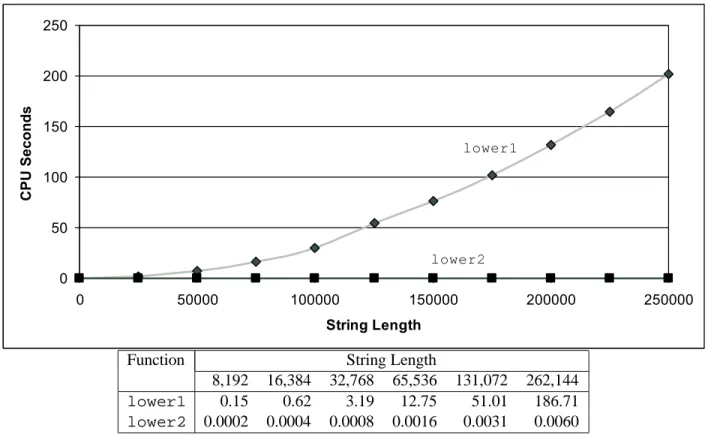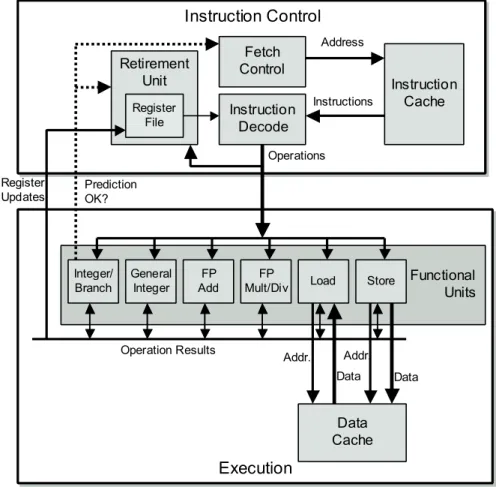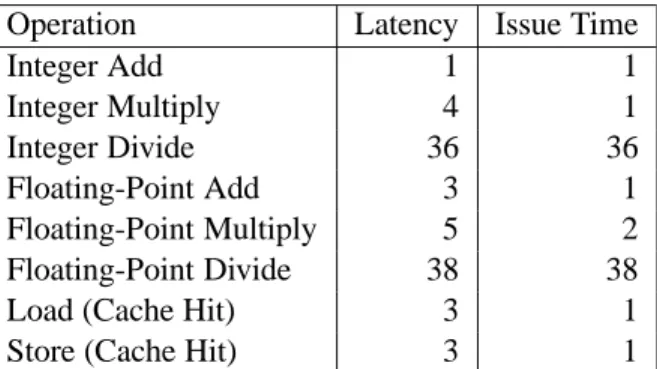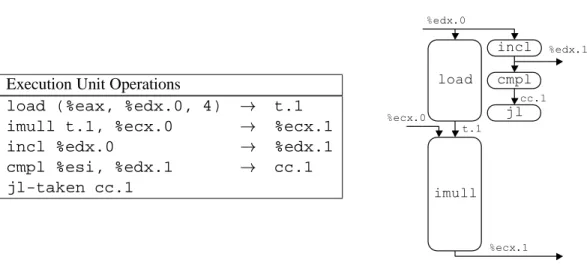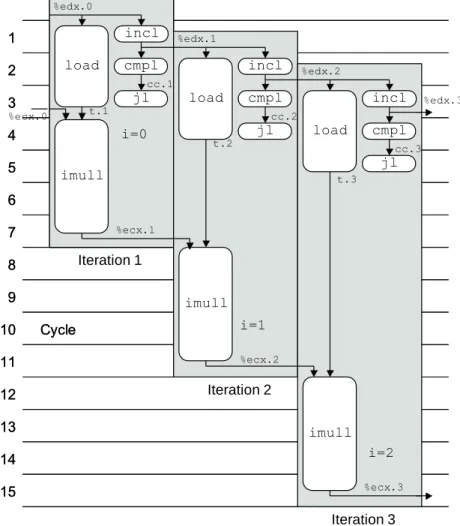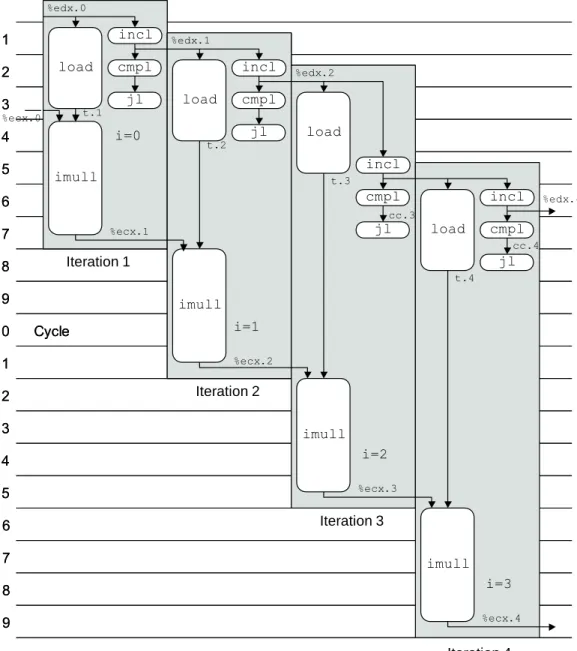For example, Figure 5.2 shows a graph of the number of clock cycles required by the two functions for a range of values of . On the other hand, the length of the vector does not change as the circuit continues.
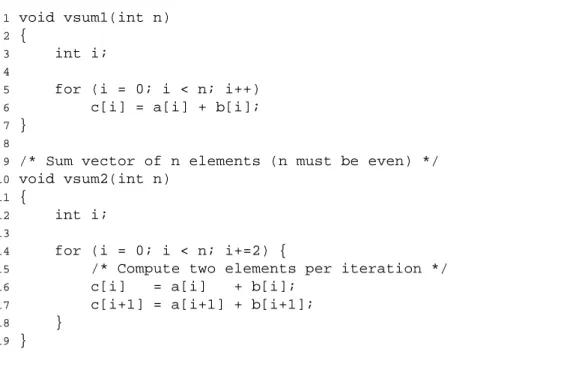
ELIMINATING LOOP INEFFICIENCIES 215 This optimization is an instance of a general class of optimizations known as code motion. They involve
ELIMINATING LOOP INEFFICIENCIES 217
Part of a competent programmer's job is to prevent such asymptotic inefficiency from ever being introduced. Complete the table below and indicate the number of times each of the four functions is called for each of these code snippets.
Reducing Procedure Calls
REDUCING PROCEDURE CALLS 219
It's a good idea to include documentation about the transformations applied and the assumptions that led to them, in case the code needs to be changed later. Saying that "performance has improved by 250%" is more difficult to understand than simply saying that performance has improved by a factor of 3.5.
Eliminating Unneeded Memory References
In principle, the user of the vector abstract data type should not even need to know that the vector contents are stored as an array rather than as some other data structure such as a linked list. The best way to express a performance improvement is as a ratio of the form , where is the time required for the original version and the time required for the modified version.
ELIMINATING UNNEEDED MEMORY REFERENCES 221 code/opt/combine.c
In the final iteration this value is then multiplied to give a final value of 36. For the combined case4, the vector remains unchanged until the end, when the final element is placed in the computed result.
Understanding Modern Processors
That is, we create an alias between the last element of the vector and the destination for storing the result. One could argue that the combination behavior closely matches the purpose of the function description.
UNDERSTANDING MODERN PROCESSORS 223
Overall Operation
Alternatively, the branch is not taken, passing control to the next instruction in the instruction sequence. It takes some time before the new instructions can be acquired, decoded and sent to the execution units.
Functional Unit Performance
Register renaming allows a whole range of operations to be performed speculatively, even though the registers are not updated until the processor is sure of the branching results. As Figure 5-12 indicates, integer multiplication and floating-point multiplication and addition were considered key operations in the design of the Pentium III, even though a significant amount of hardware is required to achieve the low latencies and high degree of pipelining shown. reaches.
A Closer Look at Processor Operation
Thus, the value in register %ecxi is identified by the label %ecx.0 at the beginning of the loop and by %ecx.1 after it is updated. We also introduce the label t.1 to indicate the value read by the load operation and passed to the imull operation, and we explicitly show the destination of the operation. As this example illustrates, tags can be associated with intermediate values that are never written to the registry file.
UNDERSTANDING MODERN PROCESSORS 229
As the graphical representation shows, all operations except load now require only one cycle. Thus, the load operation of an iteration can begin as soon as the incl operation of the previous iteration has generated an updated value of the loop index. For example, the incl operation is executed in one iteration before the instruction of the previous iteration has even begun.

UNDERSTANDING MODERN PROCESSORS 231
For example, in cycle 4 we can see that the machine is running the extension for iteration 1; different parts of loading operations for iterations 2, 3 and 4; repeat iteration 2; thecmpl for iteration 3; and included for iteration 4. In contrast, the graph of Figure 5.15 has three of these operations in parallel in loop 3 and four in parallel in loop 4. For example, in loop 3 of the graph of Figure 5.15, we show three integer operations that are executed: thejlof iteration 1, cmplof iteration 2, and inclof iteration 3.
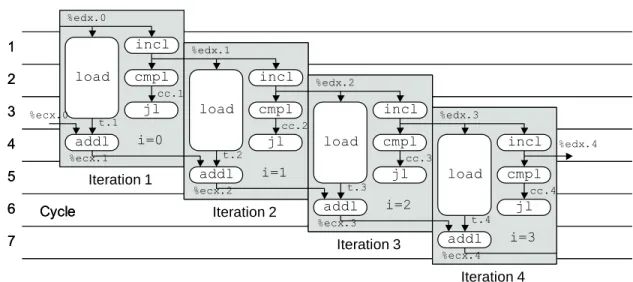
UNDERSTANDING MODERN PROCESSORS 233
In this example, we would postpone the incl operation since any operation of iteration 3 is later in the program order than those of iterations 1 and 2. Similarly, in cycle 4 we would prioritize the imull operation of iteration 1 and thejof iteration 2 over that of the incl operation of iteration 3. Observe how the timing of all operations in iterations 4 and 8 are identical, except that the operations in iteration 8 occur eight cycles later.
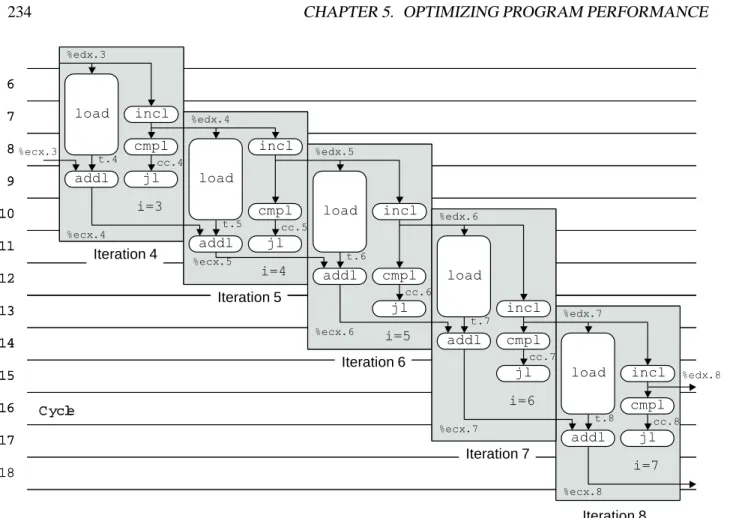
REDUCING LOOP OVERHEAD 235 cycles, achieving the optimum CPE of 2.0
Reducing Loop Overhead
REDUCING LOOP OVERHEAD 237 Execution Unit Operations
LOOP DECREASE 239 shows that when we reach iteration 3 (i), the operations would follow the usual pattern.
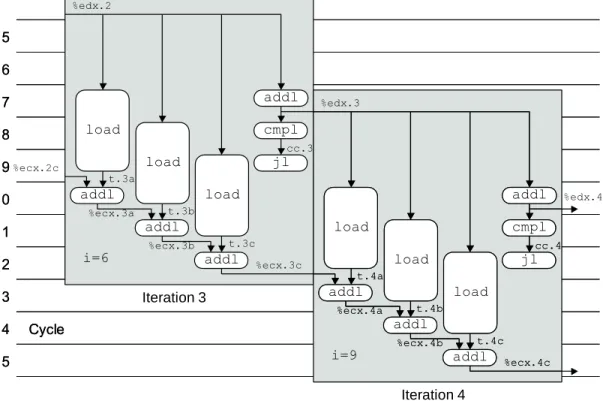
In this case, it seems like a small price to pay for code that runs almost twice as fast. In other cases, however, the optimal position in this time-space trade-off is not so clear.
Converting to Pointer Code
CONVERTING TO POINTER CODE 241
Although the two programs are very similar in structure, the array code requires two cycles per iteration, while the pointer code requires three. Show the general form with random data and combination operation in the style of Figure 5-19.
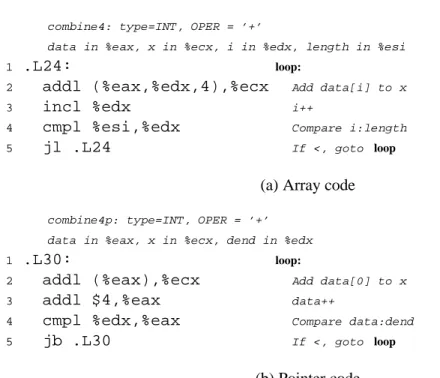
ENHANCING PARALLELISM 243 code/opt/combine.c
Enhancing Parallelism
Loop Splitting
It uses both two-way loop unwinding to combine more elements per iteration, and two-way parallelism, collecting elements with even indexes in variable x0, and elements with odd indexes in variable x1. As before, we add a second loop to collect remaining array elements in case the vector length is not a multiple of 2.
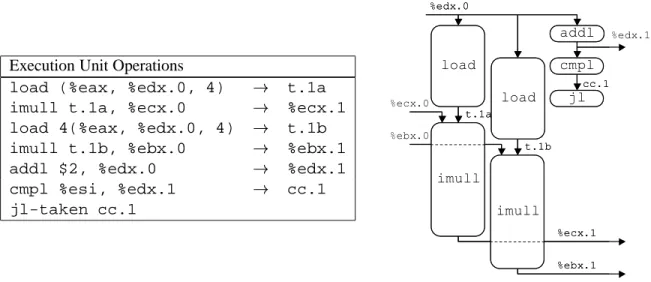
ENHANCING PARALLELISM 245 Assembly Instructions Execution Unit Operations
ENHANCING PARALLELISM 247 patterns are unlikely. Since most physical phenomena are continous, numerical data tend to be reasonably
Register Spilling
This code uses a stack location to hold x6, one of eight local variables used to collect sums. The code loads it into a register, multiplies it by one of the data elements, and stores it back in the same stack location. The following shows the code generated from a variant of combine6 that uses eight-way loop unwinding and four-way parallelism.
PUTTING IT TOGETHER: SUMMARY OF RESULTS FOR OPTIMIZING COMBINING CODE249
Limits to Parallelism
Putting it Together: Summary of Results for Optimizing Combining Code
Floating-Point Performance Anomaly
One of the most striking features of Figure 5-27 is the drastic drop in floating-point multiplication cycle time as we go from combine3, where the product is collected in memory, to combine4, where the product is collected in a floating-point register. Examining the table, it seems that something strange happens in the case of floating point multiplication when we collect the results in memory. Such a large number can be represented in extended-precision floating-point format (it can display numbers up to approx.
BRANCH PREDICTION AND MISPREDICTION PENALTIES 251
Changing Platforms
Branch Prediction and Misprediction Penalties
If the prediction is incorrect, the processor must ignore any speculatively executed results and restart the instruction fetch process at the correct location. For this procedure, the processor was generally able to predict the direction of the branch at the end of the loop. Experiments have shown that the backward taken, forward not taken heuristic is correct about 65% of the time.
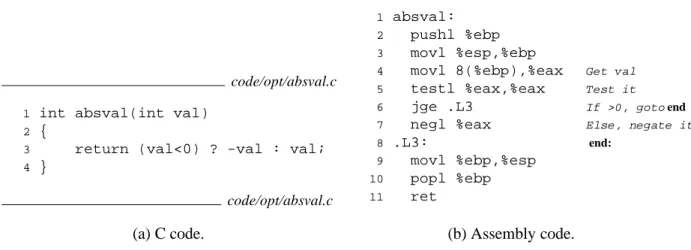
BRANCH PREDICTION AND MISPREDICTION PENALTIES 253 We time this function computing the absolute value of every element in an array, with the array consisting
Our measurements of this code show that it runs for 13.7 cycles, regardless of data patterns. Due to the desire to remain compatible with earlier 486 and Pentium processors, the compiler does not take advantage of these new features. Ultimately, we must rely on a combination of good code generation by the compiler to minimize the use of conditional branches and effective branch prediction by the processor to reduce the number of branch mispredictions.
Understanding Memory Performance
As this code shows, the strategy is to set value as a return value, compute-val, and conditionally move it to register %eax to change the return value when val is negative. A version that took advantage of GCC's ability to embed assembly code in a C program (Section 3.15) required 17.1 cycles due to lower quality code generation. Apart from this, the programmer has little control over the detailed branching structure generated by the compiler, and it is difficult to make branches more predictable.
UNDERSTANDING MEMORY PERFORMANCE 255 code/opt/list.c
Load Latency
UNDERSTANDING MEMORY PERFORMANCE 257 code/opt/copy.c
Store Latency
Since each iteration requires a store operation, it is clear that the processor can begin a new store operation at least once every other cycle. Thus, we have almost reached the optimal limit of one new store operation per cycle. Unlike the other operations we have considered so far, the store operation does not affect any register values.
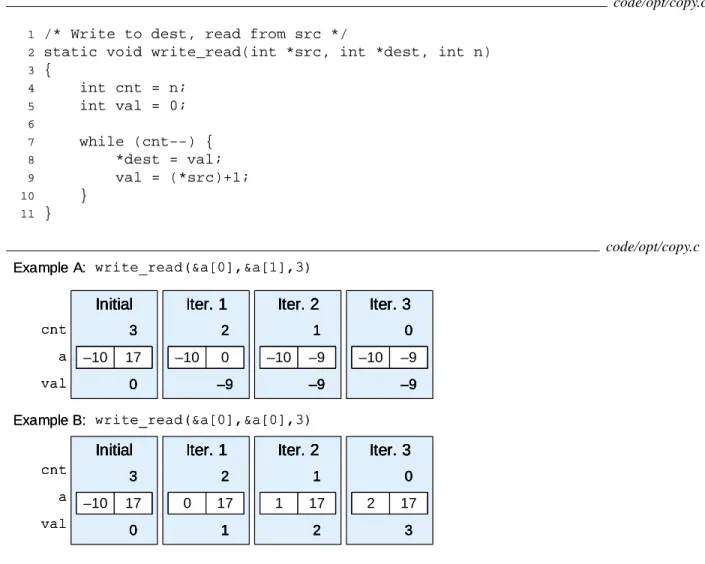
UNDERSTANDING MEMORY PERFORMANCE 259
The storage and loading operations have different addresses, so the load can proceed without waiting for the store. As indicated by the dashed line between the storeaddrandload operations, thestore-adroperation creates an entry in the store buffer, which is then checked by the load. In our calculation graph, we show the load for the second iteration starting just one cycle after the load from the first.
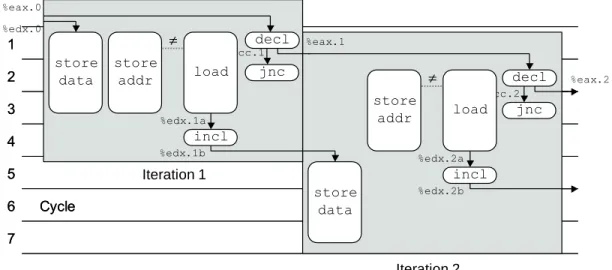
UNDERSTANDING MEMORY PERFORMANCE 261
Our performance measurements indicate that the call from part A has a CPE of 3.00, while the call from part B has a CPE of 5.00.
Life in the Real World: Performance Improvement Techniques
IDENTIFYING AND ELIMINATING PERFORMANCE BOTTLENECKS 263 A final word of advice to the reader is to be careful to avoid expending effort on misleading results. One
Identifying and Eliminating Performance Bottlenecks
Program Profiling
The first part of the profile report shows the times spent performing the various functions, sorted in descending order. The second shows the accumulated time spent by the functions up to and including the one in this row. The third shows the time spent on that particular function, and the fourth shows how many times it was called (recursive calls not included).
IDENTIFYING AND ELIMINATING PERFORMANCE BOTTLENECKS 265 counter for that function by . Of course, it may happen that this function just started executing and
Using a Profiler to Guide Optimization
IDENTIFYING AND ELIMINATING PERFORMANCE BOTTLENECKS 267 Hash Computing the hash function
Amdahl’s Law
Suppose that a part of the system requires a fraction of this time and we improve its performance by a factor of . As an example, consider the case where a part of the system that originally took 60% of the time ( ) is sped up by a factor of 3. Thus, even though we have made a significant improvement to a large part of the system, our the net speed was significantly less.
Summary
These tools can break down the execution time below the procedural level to measure performance of each basic block of the program. Amdahl's law provides a simple but powerful insight into the performance gains achieved by improving just one part of the system. The profit depends on how much we improve this part and how big a fraction of the total time this part originally required.
Bibliographic Notes
Homework Problems
SUMMARY 271 Our measurements show that this function requires 3.11 cycles per iteration for integer data. The assembly
Write a version of the inner product procedure described in Problem 5.8 that uses the four-way loop opening. Our measurements for this procedure give a CPE of 2.20 for integer data and 3.50 for floating point. Write a version of the inner product procedure described in Problem 5.8 that uses four-way ring opening and two-way parallelism.
SUMMARY 273
This code is written so that the memory access to fetch the next list element comes before the one to fetch the current element's data field. Note that the move register movl %edx,%ecx operation does not require any operations to implement. It is handled by simply associating the edx.0 tag with register%ecx, so that the later addl 4(%ecx),%eax statement translates to usedx.0 as the source operand.
